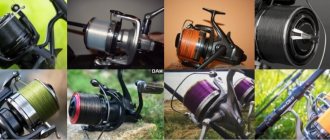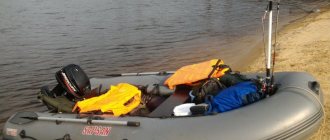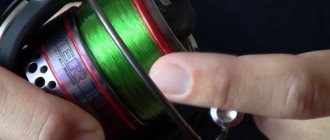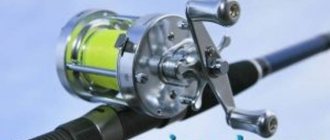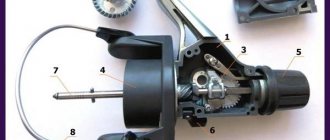You need to pull the bait to the tip of the rod, lower the line handle and grab the line with your finger. After this, the bait seems to swing and with a sharp movement from under itself is directed to the desired point. The main thing is not to forget to remove your finger from the fishing line in time.
This article is intended for those spinners who have picked up a spinning rod for the first time in their lives and are thinking about how to use it correctly and effectively. Any theoretical knowledge must be supported by practical skills. Theory and practice are the power that allows you to always have a positive result. Having mastered the basics, which are outlined in theory, it is easy to master the practice of using spinning tackle.
To successfully cast the tackle, it is important to take into account the windage of the spinner. Wobblers have a small windage, foam rubber baits have a medium windage. Silicone baits fly the farthest.
Methods and techniques for casting a spinning rod with a spinning reel
The most important thing you strive for when casting is accuracy and distance. Before throwing the tackle, you need to make sure that there are no obstacles behind at a sufficient distance - trees, bushes, poles, including living objects in the form of cattle or rivals.
How to cast a spinning rod with a spinning reel: on the other side of the river you need to select a landmark in the direction of which the bait will be thrown. At first, you can practice on sinkers with different weights. By the way, experienced fishermen use Cheburashka to study the topography of a reservoir. The absence of a hook allows you to avoid hooking.
There are not so many options on how to cast correctly, and they are common not only among spinning players, but also among feeders and floaters.
- Side cast
. Used to deliver bait over short and medium distances in strong winds or on an overgrown bank. - Casting from under yourself
. Used over short distances when another cast is hampered by obstacles around the angler. - Throwing from behind
. The rig can be thrown over extremely long distances, despite the power of the wind.
Casting a spinning rod with a spinning reel from behind is convenient if nothing interferes with it. To do this, we wind the reel until the bait is at the level of the third ring. We fix the line with a finger and fold back the line guide. When making a swing, we place the form behind our back. With acceleration, we bring the rod in front of us, removing our finger from the fixed line.
Casting a fishing rod with a spinning reel, unfortunately, is not always accurate, that is, during the fishing process it is not always possible to deliver the bait to the same zone. Therefore, you have to explore the areas, casting in various directions. And this proves that you will have to throw a large number of times.
If you need to stop the line from running off the reel, you need to either press the line against the rod, or turn the handle of the reel, which will turn on the line guide (close the bow), and the latter will stop feeding the line from the reel.
When casting with a two-handed rod, the right hand clasps the rod handle so that the reel stand is between the middle and ring fingers, and the left clasps the rod near the buffer (Fig. 1).
Rice. 1. Hand position on a two-handed rod when casting with a spinning reel from right to left.
When casting with a two-handed rod from left to right, the hands are positioned in the reverse order.
When casting with a one-handed rod, grab it with your right hand so that the stand is between the middle and ring fingers (Fig. 2).
Rice. 2. Hand position on a one-handed rod when casting with a spinning reel.
Before casting, rotate the reel handle to adjust the amount of overhang. Then the line is grabbed with the first joint of the index finger, pulled up to the rod and the line catcher is pulled back to the fullest extent so that it does not interfere with the free release of the line from the reel.
Then, having taken a comfortable position, they swing the rod and send the bait (Fig. 3 and Fig. 4).
Rice. 3. Option of casting with a one-handed rod with a spinning reel.
Rice. 4. Another option for casting with a one-handed rod with a spinning reel.
If you need to stop the line from running off the reel, you need to either press the line against the rod, or turn the handle of the reel, which will turn on the line guide (close the bow), and the latter will stop feeding the line from the reel.
Do the same if, when casting, it is desirable to reduce the falling distance of the bait. In general, it is better to regulate the casting range not by stopping the bait in flight, but by changing the force of the swing. In the previously indicated position, the reels are reeled in by rotating the handle with the left hand, and the rods are held in the right (Fig. 5).
Rice. 5. The position of the hands and the rod when reeling in the line while fishing with a spinning reel.
It is more convenient to train with an inertia-free reel on an area that does not have any obstacles for casting.
- Technical characteristics of the spinning kit.
- Type of bait used.
- The physical and psychological characteristics of the fisherman himself.
Spinning casting technique
There are several basic rules. Following them will help a novice spinning player avoid initial mistakes and cast correctly, far and accurately.
Overhang of the bait
Overhang is the distance from the bait to the tip of the spinning rod. It is often recommended to make the overhang of the bait 30-40 centimeters from the tulip, as the most optimal. But here you need to take into account such characteristics as:
Line retention when casting
There are two types of line retention when casting:
- The first is when you press the line against the side of the reel spool with your index finger.
- The second, most common, is holding at the handle of the spinning rod (as in the photo).
The position of the spinner's hands when casting
Casting a spinning rod with one hand looks beautiful, but I still recommend giving up the apparent beauty and grasping the handle with both hands. Regardless of the blank length, weight and type of bait. Each hand performs its own function.
In principle, these are the main points that first of all need to be paid attention to when mastering the technique of casting a spinning rod for a novice fisherman. Of course, there are quite a lot of nuances and you will have to get to know them. For example, the fight against overlapping tulip fishing line.
For clarity, I can offer a video about the technique of casting a spinning rod from Kirill Gushchin, where all the episodes are perfectly described.
The video is wonderful, I just want to warn beginners against completely copying the actions of a professional when working with a loaded form. Kirill has a lot of experience and good spinning. With budget Chinese chopsticks, such tricks may not work and will lead to breakdown.
Overhead throw (circular). Without exaggeration, we can say that with this method or its similar varieties it is possible to perform an accurate cast in at least 80-90 percent of fishing situations. The most important prerequisite for the correct execution of this cast is a long line overhang (in the initial position, its value is sometimes equal to the distance from the tulip to the reel). Casting can only be done with a spinning rod with a spinning reel.
Spinning fishing using spinning and multiplier reels has some features. You need to know them in order to avoid mistakes from the first steps of using this equipment and to feel its advantages and capabilities. That is why special attention must be paid to the technique of using spinning tackle. So, you have taken the prepared tackle in your hands and are about to cast. But let’s not rush, we need to be able to hold this tackle correctly.
Depending on the type of spinning or multiplier reel, one or another method of gripping the rod is used, but the basic rule is that in any case the angler can easily reach the front edge of the reel with his index finger. This is necessary to slow down the line during casting.
Braking
When using a closed spinning reel, almost the only option is sudden braking. It is carried out as follows: as soon as the bait has reached the intended place, the fishing line is slowed down by pressing the lever. Then they transfer the rod to the left hand, and begin reeling with the right hand. More advanced models allow smooth braking by smoothly pressing the lever, which brings the rubber buffer closer to the hole, thereby increasing the resistance to the line coming off.
The position of the fingers on the rod handle with the reel open: a - grip of the handle;
b - holding the fishing line. Braking the line with your finger when using an open spinning reel
The sequence of actions when casting with an open spinning reel and braking the flight of the bait with your index finger:
When using a multiplier reel, the flight of the bait is slowed down in almost the same ways as when casting with conventional inertial reels, that is, by touching the cheek of the reel with your finger. Some anglers brake directly along the line on the reel, but this technique cannot be considered the best.
Adjustment of centrifugal or magnetic brakes is carried out mainly depending on the casting style, which is why this should be done after mastering casting. The instructions that came with the reel usually contain instructions in this regard.
Only after mastering braking techniques can you begin to master casting. It is very advisable to do this in a spacious area, stadium, meadow. It’s even better to do this in the winter or spring in the gym under the guidance of an experienced spinning player or coach. The bait should be replaced with a sinker.
Casting technique
Overhead throw (circular). Without exaggeration, we can say that with this method or its similar varieties it is possible to perform an accurate cast in at least 80-90 percent of fishing situations. The most important prerequisite for the correct execution of this cast is a long line overhang (in the initial position, its value is sometimes equal to the distance from the tulip to the reel). Casting can only be done with a spinning rod with a spinning reel.
Casting over the head does not require a lot of free space: with a certain skill, it is enough to find some opening in the thickets. It can be carried out in different planes, up to the point that the rod in its original position is horizontal. The casting trajectory will be very flat.
If you cast over your head traditionally, that is, with a short overhang and with an inertial reel, the accuracy of the hit is much less, as is the ability to control the flight path of the spoon.
Pendulum casting is considered the simplest. Mastering the technique usually begins with this. It allows you to throw a lure in a limited space along a low trajectory at a distance of up to 15 meters. Only possible with a spinning reel.
If in the initial position you tilt the rod to the right or left, the pendulum cast gradually turns into a side cast, in which the rod is held almost horizontally (to the left or to the right).
Side casts are quite easy to perform. They are used in hard-to-reach areas of rivers, especially in situations where a low casting trajectory is required.
Catapult casting is rarely used, almost exclusively with light-class spinning rods. It sometimes allows you to cast a spoon in places where this cannot be done in any other way. This can only be done with a spinning rod and a spinning reel.
Power casts are modifications of an overhead cast, when all its phases are performed with greater amplitude and force. In this way and with an appropriately equipped spinning rod, you can send a spinner at 120-140 meters (the usual casting range does not exceed 50-60 meters). Power casts are used only in cases of extreme necessity, mainly when using a two-handed spinning rod. They are convenient when fishing from the shore on large and medium-sized rivers or lakes with clean, accessible banks.
Adjusting the Friction Brake
Having mastered the casting technique, you need to learn how to properly adjust the friction brake of your reel. To do this, you need to know the strength of the fishing line used and adjust the brake with the expectation of a force at least 20-40 percent below the tensile strength of the fishing line. Typically, the brake is set to about half this strength - for greater reliability. All this can be easily done at home using a dynamometer.
On a pond, the following circumstance must also be taken into account: in the case of a significant decrease in the amount of fishing line on the reel (for example, when casting far), the force at which the fishing line recoils can increase significantly, since as the winding diameter decreases, the force at which the reel slips increases accordingly . If you catch a large fish, you need to loosen the brake a little.
- Pendulum cast.
- Side cast.
- Shooting (catapult) cast.
- Power cast.
- Overhead throw.
How to choose a spinning rod
The water, the fish and the fishing method, not to mention the angler's personal preferences, determine his equipment.
Spinning rod for catching small fish
To catch small fish, you need a short, lightweight rod with a length of 150 - 180 centimeters, a small reel with a spool capacity of 100 - 125 meters of fishing line, with a diameter of 0.10 - 0.23 millimeters, tested for strength. Choose a rod designed to cast bait weighing from 2 to 10 grams. This equipment is best suited for fishing for small trout, American bass and pike, and for fishing from a boat in small ponds, rivers and streams.
Spinning rod for catching medium fish
Lightweight spinning equipment consists of an elastic rod 210 - 250 centimeters long, designed to cast bait weighing 10 - 20 grams, a small reel and fishing line with a diameter of 0.23 - 0.30 millimeters. A lightweight rod with an extended handle for two-handed casting gives you greater control and expands your capabilities.
Spinning rod for catching large fish
A classic multi-purpose set consists of a rod 230 - 320 cm long, designed to cast bait weighing 12 - 28 grams, a medium-sized reel and 150 - 180 meters of fishing line with a diameter of 0.25 - 0.35 millimeters. This equipment is strong enough for casting medium-weight lures such as wobblers, oscillating and rotating spoons. With its help you can even compete with such serious opponents as pike, salmon and lake trout.
Spinning rod for fishing from a boat and trolling
For fishing from a boat, the most practical rod is 210 - 250 centimeters long, designed to cast baits weighing 12 - 28 grams. It takes up less space, but has the same positive qualities. With an extended handle for two-handed casting, these rods are quite powerful. Trolling or casting heavy baits requires more substantial equipment. Landing really big fish like salmon and big bass usually requires the use of a special rod. These rods can range from 210 to 350 centimeters in length, depending on whether they are used for trolling from a boat or for fishing from the shore. They are always equipped with a two-handed handle, as they are designed for long casting.
The most commonly used casting options are vertical and side
Vertical cast
It is believed that vertical casting of bait has maximum accuracy and range. This casting option is well suited for large bodies of water with a fairly clean shore, on which there are no trees hanging low over the water, or a wall of bushes reaching right down to the water. The technique of casting a spinning rod vertically is quite simple:
- First, you should select the length of the line overhang (depending both on personal preferences and on the characteristics of the bait and rods), open the line handle, and the line or cord is fixed with your index finger.
- The form must be placed behind your back.
- With a quick movement of the rod you need to send the bait forward, and it is important to release the line in a timely manner.
It should be taken into account that when fishing under power lines, this technique is the most dangerous - if you do not release the line in time, the bait can go quite high up and remain on the wires. This situation can be dangerous for the fisherman himself, because carbon blanks conduct electricity well.
Photo 1. Vertical casting diagram.
Side cast
The technique of the cast itself is almost the same as in the case of vertical casting, only the rod must be moved not back, but to the side. As a rule, right-handers throw in the direction from right to left, left-handers vice versa, but sometimes there are situations when it is useful to be proficient in both options.
Photo 2. Side casting diagram.
- The influence of the current if we fish in flowing waters.
- We roughly estimate the amplitude of movement of our bait.
- The fish will not want to follow the bait that is facing the sun, so we choose a place to cast at a low angle to the sun's rays.
Balance of reel and spinning rod, selection rules
20 March 2012 15:56
It is unlikely that anyone will dispute the opinion that fishing is, first and foremost, pleasure. That is why any spinning player wants to get maximum positive emotions both from communicating with nature and from comfortable possession of his tackle. In the latter case, this directly depends on the overall balancing of the tackle, on how well the reel is suitable for a particular fishing rod. The optimal balance of gear means the best match between the reel and the rod in terms of weight, power and sensitivity. Let's look at all these factors in more detail. It is very simple to determine how well a reel with wound fishing line or cord balances a spinning rod. Place the assembled tackle on your index finger and find the center of gravity. If the center of gravity coincides with the grip point, the tackle is well balanced in weight. You can fish with pleasure all day long with this spinning rod, without subsequently feeling any discomfort in your joints and muscles. A well-balanced “reel-rod” system subjectively seems lighter and more sensitive than gear that “pecks” with its nose or falls back. With these options, your arm and back will quickly “ache” and fishing will turn from pleasure into a kind of masochism.
In addition to weight, the reel should also be in harmony with the fishing rod in terms of power. For example, let's use the classification of Shimano reels (Japan)
.
Reels of size 500/1000
are suitable for ultra light class spinning rods with a test weight of up to 7g, sizes
1500/2000
are for light and medium-light rods with a test weight of up to 15-20g, size 2500 is universal and suitable for spinning rods with a test weight of up to 25-30g, reels of standard size over
3000
, as a rule, are installed on powerful long rods for catching large predators. Of course, this classification is not strictly mandatory; often, when mechanically balancing gear, it is better to install a lighter or more powerful reel, depending on the length and weight of the rod.
Casting range and accuracy is another consequence of harmonious spinning tackle. When the place of grip coincides with the center of gravity, the tackle begins to have the best casting properties. The fact is that during casting, your hand with a spinning rod is like a lever, “shooting” the bait forward. The acceleration and impulse of the cast will depend on how well the tackle is balanced. The same applies to casting accuracy. Having practically no parasitic vibrations, a clearly adjusted tackle will allow you to direct your hand with a spinning rod, and behind it the bait, exactly to the target. By the way, such high-precision tackle will also help you when choosing bait. Having practiced casting different types of spinners, you will very soon determine for yourself which specific baits fly most accurately and far from your spinning rod. By saving money on the purchase of baits you don’t need, you will quickly equip your gear with a set of the most “killer” spinners in the literal sense.
The sensitivity or sensitivity of the gear is the last, but no less important, characteristic of a well-balanced reel-rod system.
Being directly in the very center of gravity of the spinning rod, your hand will most accurately determine what is happening with the bait at any given time. Any shocks and stops in the wiring will be immediately transmitted to your hand. Remember that the lighter your reel and spinning rod, the more sensitive the tackle will be overall. That is why all leaders in the production of gear strive to lighten all elements of gear through the use of the most modern and high-tech materials. And who among the fishermen will refuse to reduce their pleasure from biting and fishing for a predator with highly sensitive balanced tackle? Liked? Share with your friends!
Which type of casting should you choose and why?
- Lateral - perfect for abundant vegetation, which will interfere with spinning casts and a head gust of wind.
- Over the head - any fisherman dreams of making the most accurate cast, in this case this method is perfect. The accuracy of this type reaches almost 100%.
- Underhand is the best method when fishing with two people on a boat, or when there is dense vegetation directly behind the fisherman on the shore.
- Over the shoulder - you can safely choose it on the shore in a narrow space.
- With both hands - by casting with this method, the fisherman will get the most powerful result.
There are two types of line retention when casting:
How to cast a spinning rod correctly?
Before throwing, be sure to follow the following rules:
- It is imperative to carefully look around to see if there are people, trees, or bushes behind you, but the most important thing to do is to look up to see if there are any wires that can cause serious harm to health. It is also desirable that there are no overhanging branches over your head, to which hooks and fishing line will cling when casting.
- Release the line at an angle of 45 degrees if you want to make the longest cast.
- Casting accuracy can only be learned over time by making a large number of casts while fishing, swinging the rod with a certain effort and releasing the line at the most appropriate time, and then not forgetting to point it in the right direction. Here the best teacher will be time and constant training.
When fishing with a spring, you should know that the weight of the tackle is of great importance.
But fishermen recommend adhering to the following tips:
- First, place the spinning rod on your shoulder.
- Then we rock the ball with bait a little.
- At the moment when the spring, swinging, takes the farthest direction from the back, quickly cast, not forgetting to gradually increase the flight speed and release the line at an angle of 45 degrees.
This will unload the rod and line, which will prevent the spinning rod from breaking.
Spinning casting technique
There are several basic rules. Following them will help a novice spinning player avoid initial mistakes and cast correctly, far and accurately.
Overhang of the bait
Line retention when casting
There are two types of line retention when casting:
- The first is when you press the line against the side of the reel spool with your index finger.
- The second, most common, is holding at the handle of the spinning rod (as in the photo).
The position of the spinner's hands when casting
Casting a spinning rod with one hand looks beautiful, but I still recommend giving up the apparent beauty and grasping the handle with both hands. Regardless of the blank length, weight and type of bait. Each hand performs its own function.
In principle, these are the main points that first of all need to be paid attention to when mastering the technique of casting a spinning rod for a novice fisherman. Of course, there are quite a lot of nuances and you will have to get to know them. For example, the fight against overlapping tulip fishing line.
For clarity, I can offer a video about the technique of casting a spinning rod from Kirill Gushchin, where all the episodes are perfectly described.
The video is wonderful, I just want to warn beginners against completely copying the actions of a professional when working with a loaded form. Kirill has a lot of experience and good spinning. With budget Chinese chopsticks, such tricks may not work and will lead to breakdown.
Cloudflare Ray ID: 63aa262e9d73735b • Your IP: 195.64.208.251 • Performance & security by Cloudflare
like a catapult.

